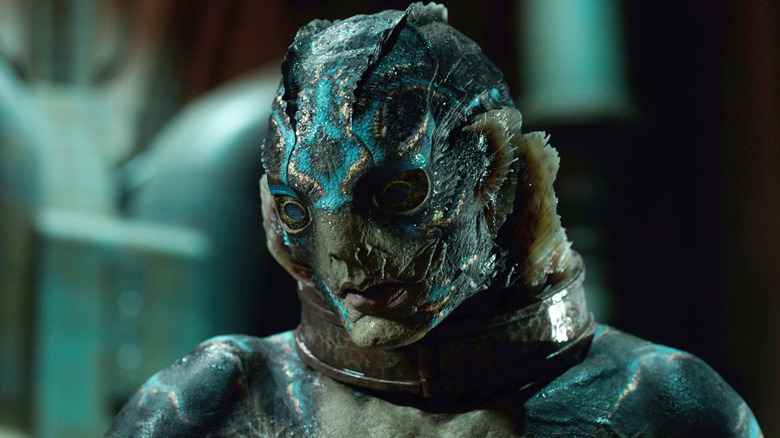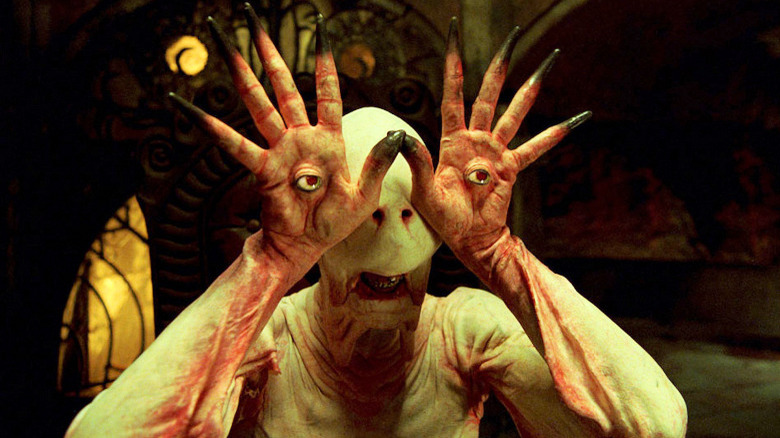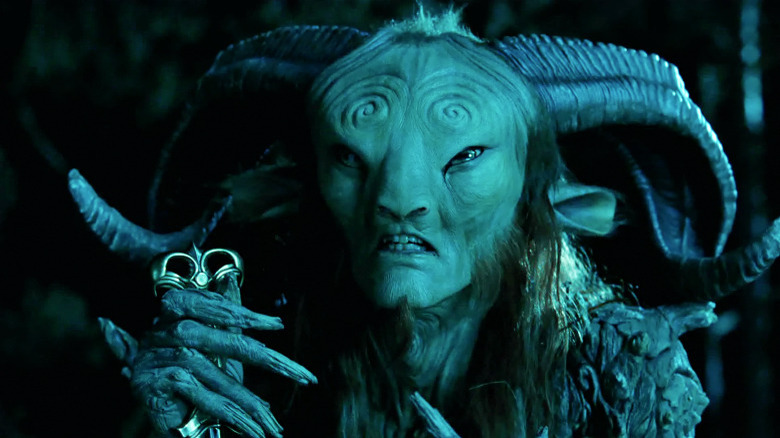Guillermo Del Toro Knows What Goes Into Making A Good Movie Monster
If there's one thing Guillermo del Toro knows in-and-out (and there's certainly more than one), it's how to create a compelling monster. His filmography as a director is filled with memorable creatures, from the eccentric customers of the Troll Market in "Hellboy II: The Golden Army" — whose ranks include a tumor-baby in the vein of Kuato from "Total Recall" — to the decaying, blood-stained specters that haunt Allerdale Hall in "Crimson Peak." What's more, del Toro's monsters come in all shapes and size. As "The Shape of Water" sculptor Mike Hill recalled, del Toro told him to give the film's Amphibian Man "a soul" while designing it, along with "kissable" lips and "a nice butt" to ensure that it was sexy enough to convince audiences that a human could fall in love with it.
"The first thing you have to resolve is the silhouette," del Toro told Cinephilia & Beyond, explaining his process for bringing a movie monster to life. "Once the silhouette captures the gait and personality of the character, then you define color," he added, noting that too many people start with "the details" first, which he feels is a mistake:
"A lot of people say, 'I want a creature with five wings and huge tentacles and teeth,' and they start accumulating. And I think a great creature is never done by accumulation but by doing each element very, very carefully."
'You have to question everything'
As meticulous as del Toro's movies are when it comes to fashioning their monsters, they're equally detail-oriented when it comes to their production design. Even when his films include nods to his earlier work (like the fritzing "Jesus Saves" neon sign in "Nightmare Alley"), they have to serve the story and act as more than just Easter eggs. In the case of his esteemed horror-fantasy movie "Pan's Labyrinth," del Toro and his crew styled its creatures to work in tandem with their surroundings, as opposed to coming up with what they felt was a cool-looking monster and then crafting its environment separately. This was especially the case when it came to the Pale Man, which del Toro feels is "perhaps the best creature I've done":
"The Pale Man is color-coded in flesh tones and deep, deep red. And everything around him is color-coded in red. Every piece of food on the table is red. The checkered flooring is red, the walls are red. The shapes are round and sort of rhyme with him; we sculpted the table and chair so they would feel of a piece with him. When you enter, you're not entering a set with a creature, you're entering a world. So when you decide about the eyes, you say, eyes or no eyes? What shape of eyes? What color of eyes? Is the absence of eyes going to be more expressive than if it has eyes? How many? Is it symmetric or asymmetric? Because you have to question everything."
This approach speaks to what del Toro feels is the difference between creating eye candy and what he calls "eye protein." As he told the Los Angeles Times in 2015, it all comes down to making sure a film's costumes, sets, and creatures give you "part of the story" and exist to be more than simply aesthetically-pleasing. He argued this was very much the case with the outfits in "Crimson Peak," stating, "Every stitch in the wardrobe is deliberately planned. We imported lace that was created in the 1800s for real. Everything [within] the movie is telling you something."
Eye protein vs. eye candy
Expanding on this idea, del Toro explained to Cinephilia & Beyond that eye candy is "something that you eat visually, but is superfluous to the storytelling: It looks good but it doesn't tell the story." Eye protein, on the other hand, can be just as "beautiful and technically complex" as eye candy, but it actually "tells the story" and brings greater depth to the movie's shiny surfaces.
Eye protein, as del Toro defines it, can also take on many forms, be it a single "complex camera move" in an Alfred Hitchcock film or "an incredibly complex, technical exercise" in the vein of "Gravity." Indeed, as I wrote about recently, Alfonso Cuarón's acclaimed space thriller is filled with imagery that allude directly to its lead character's figurative death and rebirth over the course of the movie, making it a case where (to quote del Toro) "essentially the form is the story."
This all goes back to what del Toro said about designing the creatures and sets for "Pan's Labyrinth" and how its carefully-coordinated visuals bring deeper layers of meaning to its story. If done correctly, the filmmaker argued, you can end up with a film that's as "profound" as it is "very entertaining" to watch. He pointed to "Pan's Labyrinth" as a movie where the style and substance are one and the same when it comes to its deconstruction of classic fairy tale tropes. "It is ciphering the fable audio-visually as much as it's doing it through the screenplay, which is only one layer of the storytelling," he added.


